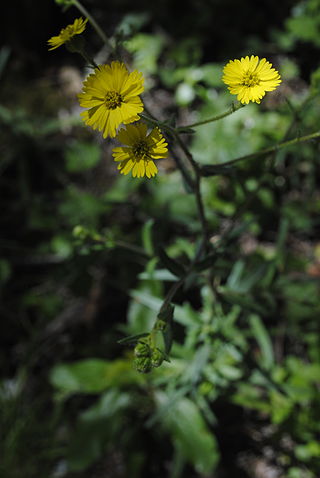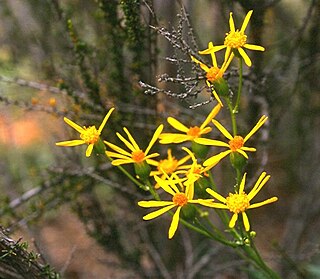
Coreopsis bigelovii is a species of flowering plant in the daisy or sunflower family, Asteraceae, with the common names Bigelow coreopsis and Bigelow's tickseed. It is endemic to California.

Coreopsis calliopsidea is a species of flowering plant in the daisy family known by the common name leafstem tickseed. It is endemic to California. The plant grows in some of the southern coastal mountain ranges and Transverse Ranges and the Mojave Desert from Alameda and Inyo Counties south to Riverside County.

Helianthella californica is a species of flowering plant in the family Asteraceae known by the common name California helianthella. This wildflower is native to the mountains of California, northwestern Nevada, and southwestern Oregon.

Hymenoxys cooperi is a species of flowering plant in the daisy family known by the common name Cooper's rubberweed. It is native to the southwestern United States and Great Basin, where it grows in rocky soils in arid regions from southern California to New Mexico, north as far as Idaho and Oregon.

Baileya pleniradiata is a North American species of flowering plant in the daisy family, Asteraceae. It is known by the common name woolly desert marigold. It is native to desert regions of the southwestern United States and northern Mexico, where it grows in sandy habitats. It has been found in the States of Chihuahua, Sonora, Baja California, Arizona, Utah, and Nevada.

Calycadenia multiglandulosa is a species of flowering plant in the family Asteraceae, known by the common names sticky calycadenia and sticky western rosinweed. It is endemic to California, where it is a common in the Coast Ranges and in the Sierra Nevada Foothills from Shasta County to Kern County.

Calycadenia villosa is an uncommon species of flowering plant in the family Asteraceae known by the common name dwarf western rosinweed. It is endemic to central California, where it is known from a limited distribution in the Central Coast Ranges in Monterey County and San Luis Obispo County, with a few populations in Santa Barbara and western Fresno Counties. There are perhaps 16 occurrences.

Coreopsis douglasii is a species of flowering plant in the family Asteraceae known by the common name Douglas' tickseed. It is native to California from Santa Clara County to San Diego County, as well as from Mohave County in Arizona.

Crepis acuminata is a North American species of flowering plant in the family Asteraceae known by the common name tapertip hawksbeard. It is native to the western United States where it grows in many types of open habitat.

Crepis intermedia is a North American species of flowering plant in the family Asteraceae known by the common name limestone hawksbeard. It is native to the Pacific Northwest, Columbia Plateau, Great Plains and Southwestern regions of western North America.

Crepis pleurocarpa is a North American species of flowering plant in the family Asteraceae known by the common name nakedstem hawksbeard. It is native to the western United States (Washington, Oregon, northern California and western Nevada.

Anisocarpus madioides is a North American species of flowering plant in the family Asteraceae known by the common name woodland madia.

Packera bernardina is a rare species of flowering plant in the aster family known by the common name San Bernardino ragwort.

Packera bolanderi is a species of flowering plant in the aster family known by the common names Bolander's ragwort and seacoast ragwort. It is native to the west coast of the United States from Washington to northern California, where it grows in wet coastal forests and woodlands. There are two varieties of the species which differ slightly in morphology and habitat occupied; these varieties have been considered separate species by some authors. The var. bolanderi has thicker leaves, occurs farther south, and occupies more open types of habitat, than does var. harfordii. This plant in general is a perennial herb producing one to three stems up to half a meter tall. The basal leaves have blades up to 12 centimeters long which are divided into several lobes and borne on long, thin petioles. Leaves growing farther up the stem are smaller and have more lobes on their blades. The inflorescence contains several flower heads, each lined with dark green phyllaries. The head contains many golden yellow disc florets and generally either 8 or 13 yellow ray florets each over a centimeter long. The fruit is an achene tipped with a pappus of bristles.

Packera clevelandii is an uncommon species of flowering plant in the aster family known by the common name Cleveland's ragwort. It is endemic to California, where it is known from only two small regions, a section of the North Coast Ranges around Napa County and a part of the Sierra Nevada foothills on the opposite side of the Sacramento Valley. The plant grows in shrubby chaparral on serpentine soils.

Packera subnuda is a species of flowering plant in the aster family known by the common names Buek's groundsel and cleftleaf groundsel. It is native to western North America from the Northwest Territories to northern California to Wyoming, where it grows in high mountain meadows in subalpine and alpine climates.

Packera eurycephala is a species of flowering plant in the aster family known by the common name widehead groundsel. It is native to a section of the western United States encompassing southern Oregon, northern California, and northern Nevada. It can be found in dry habitat types, often in disturbed areas, and it favors serpentine soils.

Packera ganderi is a rare species of flowering plant in the aster family known by the common name Gander's ragwort. It is endemic to southern California, where it is known from a few occurrences in San Diego and Riverside Counties.

Packera greenei is a species of flowering plant in the aster family known by the common name flame ragwort. It is endemic to northern California, where it is known from the North Coast Ranges and southern Klamath Mountains. It is a resident of dry mountain scrub habitat, often on serpentine soils.

Packera layneae, known by the common name Layne's ragwort and Layne's butterweed, is a rare species of flowering plant in the aster family.




















